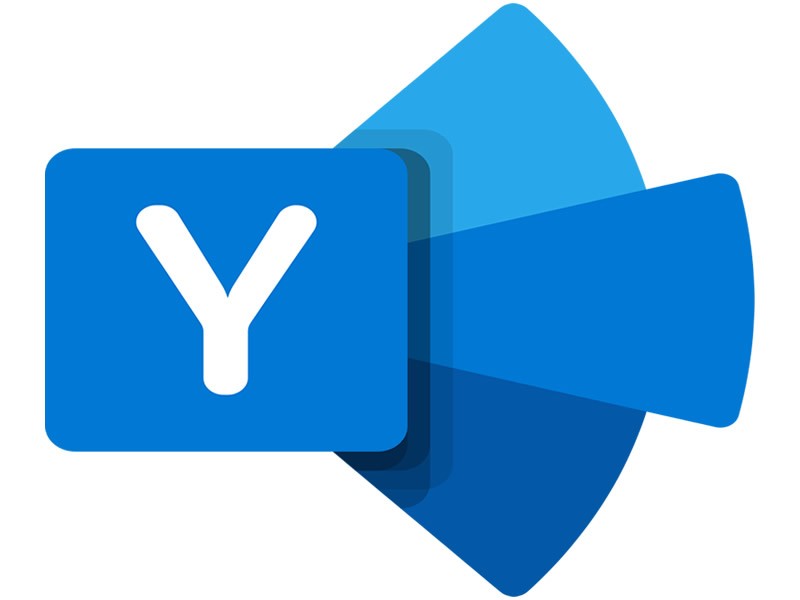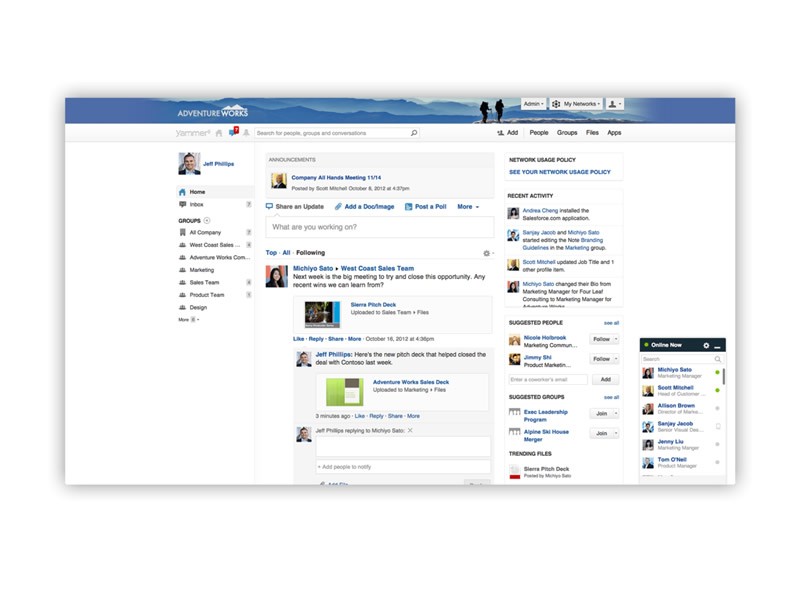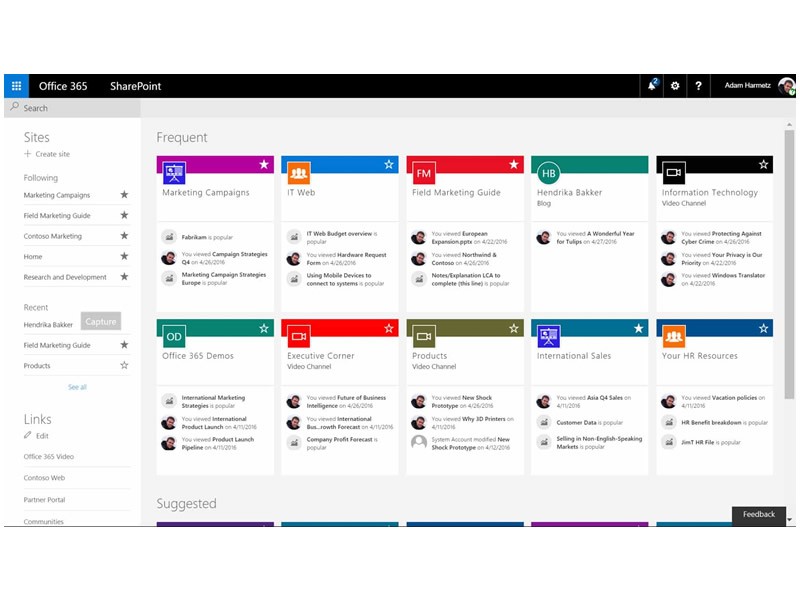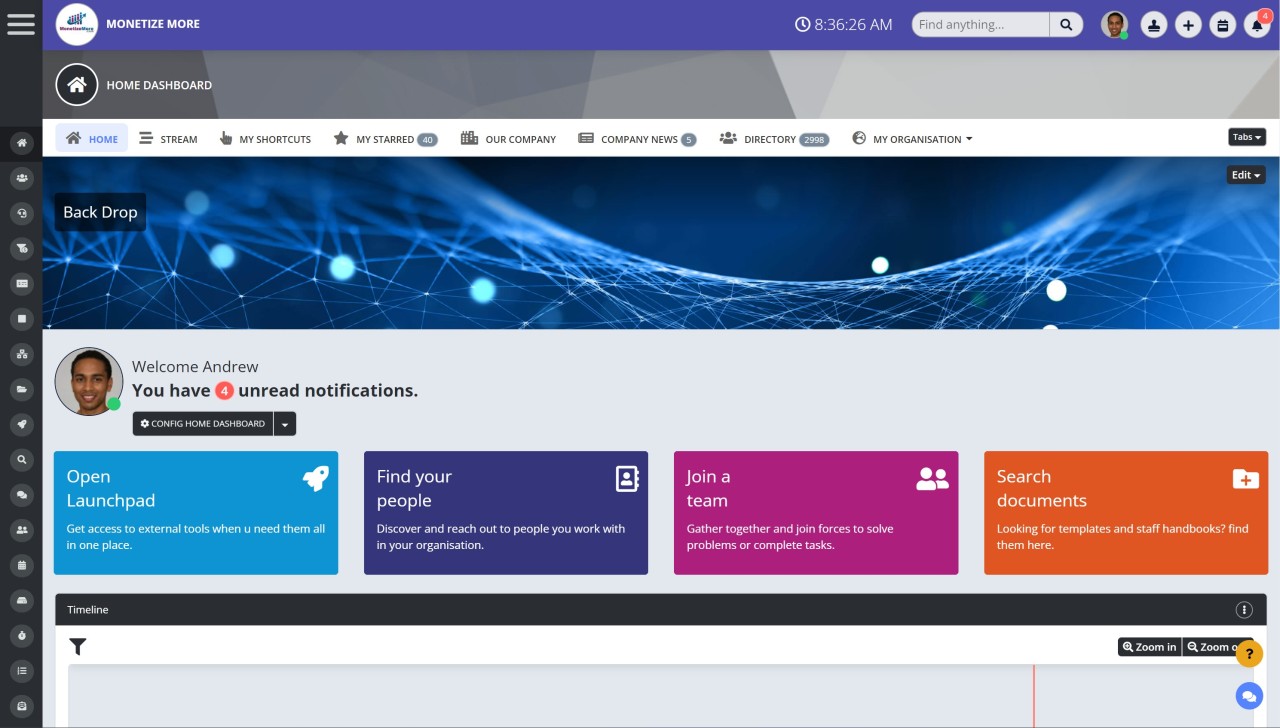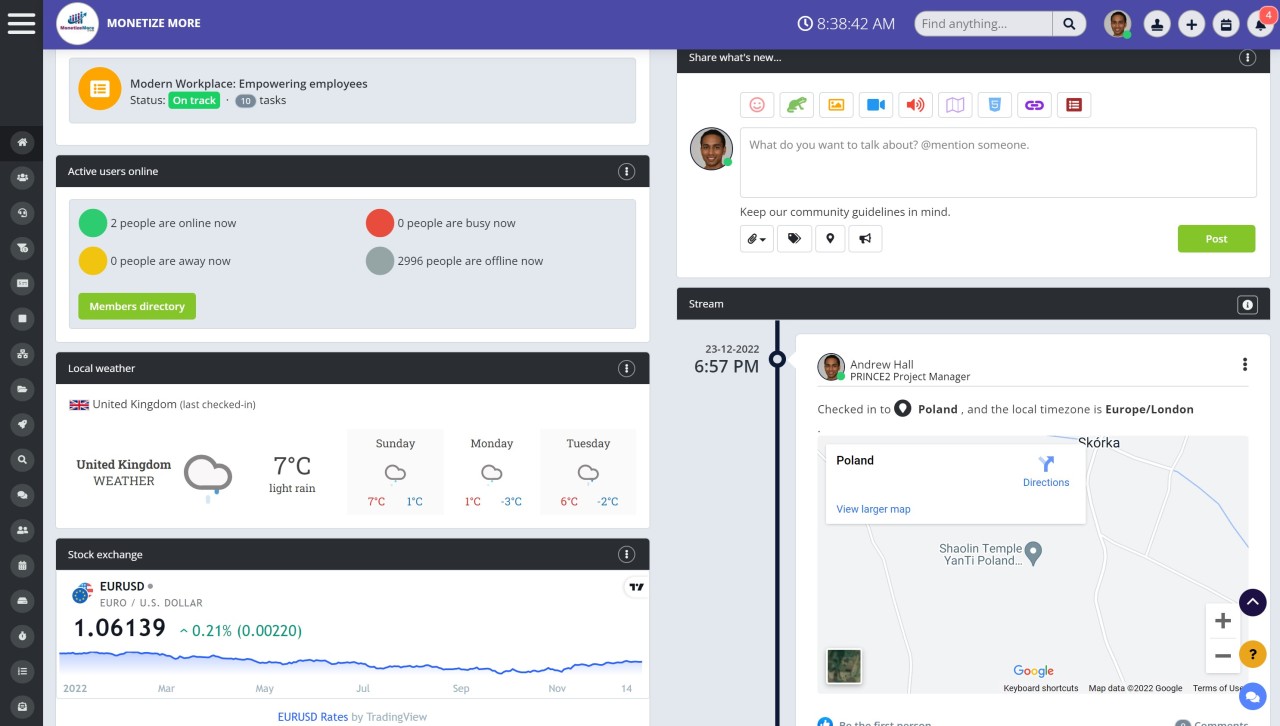Insight Blog
Agility’s perspectives on transforming the employee's experience throughout remote transformation using connected enterprise tools.
23 minutes reading time
(4547 words)
Yammer vs intranet vs Teams: Similarities and differences
Yammer vs intranet vs Teams: It keeps Teams for work-related conversations and getting work done, whilst Yammer can become a space for the more social side of things. Let dive in a bit more in the the Similarities and differences.
Yammer, intranet, and Teams have similar features, but how they are used differs. For example, Microsoft's suite of applications has several tools that are great for working together, getting employees more involved, and sharing information within the company. But because a lot of this functionality starts to overlap, it can be hard to figure out the best way to use each tool, and our customers may stop using an app or not use it the way it was meant to be used.
In this article, we'll talk about each software, what it was made to do, and how it was meant to be used. As we've already said, some features start to overlap and can be done with more than one software, so we'll try to explain more and give our recommendation.
Let's start by giving a quick overview of each software, focusing on how it is used for collaboration, engagement, and communication.
yammer vs intranet
Yammer: What is it, and how does it work?
Yammer is a social media platform for businesses where employees can connect, see each other's profiles, chat, and work together differently.
Yammer started out small. In March 2008, it was just a way for the commercial genealogy website Geni.com to talk to its own employees. Six months later, the app's creator, David O. Sacks, who was a big part of PayPal's success, took it to TechCrunch50 to get more investors' attention.
The app then went through several redesigns, with the 2010 addition of chat, polls, Q&A, events, topics, and others being perhaps the most important. It quickly grew from 2010's one million users to the next year's four million users.
In 2013, Microsoft bought Yammer and added it to its Office 365 plans. Since then, the app has been redesigned a few times, and its place in the Microsoft enterprise ecosystem has slowly changed to reflect the changes that have happened at the parent company level.
Advantages of using yammer
Yammer is a social networking service for businesses that allows employees to communicate and collaborate with each other. It can be accessed via a web browser or through mobile apps. Some benefits of using Yammer include:
- Improved communication and collaboration: Yammer allows employees to share ideas, collaborate on projects, and communicate with each other in real-time. This can increase productivity and help teams work more efficiently.
- Better organization: Yammer allows you to create groups for specific projects or teams, which makes it easier to stay organized and stay on top of tasks.
- Enhanced employee engagement: By providing a platform for employees to connect and collaborate, Yammer can help improve employee engagement and foster a sense of community within the company.
- Increased transparency: With Yammer, employees can see what others are working on and stay up to date with the latest company news, which can increase transparency and improve trust within the organization.
- Improved knowledge sharing: Yammer allows employees to share their knowledge and expertise with others, which can help improve the overall knowledge base of the organization.
Overall, Yammer can be a valuable tool for improving communication and collaboration within a business.
Disadvantages of using yammer
- You can't just download Yammer without using the other parts of the Office 365 Suite.
- You also can't get Yammer as a private user. To use the platform, you need to be part of a business and have a company email.
- That tells us a lot about what Yammer is for: it's for businesses with a lot of employees, mostly larger ones. Some of these employees might not even know each other, so they need a way to connect, get to know each other better, and work on projects together.
- But, as we'll see, Yammer isn't very good at task management or advanced collaboration, so it's safe to say that it's more of a social tool than an organizational one.
Microsoft SharePoint as an intranet
Microsoft SharePoint is a web-based platform that works with Microsoft Office to store and share files. It is designed with the customer in mind and can be changed in many ways.
In simple terms, it is a system for managing documents and other types of content. It gives organizations safe places to work and helps its employees coordinate and talk with their teams. This means that they can make tasks, keep track of schedules, and find any information about their daily jobs or projects.
SharePoint is a business intranet that has a lot to offer. Using the same tools, you can build a website for customers or a site for your team that works well. It also lets you share information with people you work with outside your company.
Advantages of using Microsoft SharePoint as an intranet
SharePoint allows businesses to create a central location for storing, organizing, and accessing documents, data, and other resources. It provides tools for creating and managing websites, as well as for collaborating on documents and projects.
Some benefits of using SharePoint as an intranet include:
- Improved communication and collaboration: SharePoint provides a central location for teams to share information and collaborate on projects, which can help improve communication and productivity.
- Enhanced document management: SharePoint allows you to easily store, organize, and access documents, and provides tools for version control and document tracking.
- Increased security: SharePoint includes built-in security features, such as user authentication and permission controls, to help ensure that sensitive information is only accessible to authorized users.
- Customization and integration: SharePoint can be customized and integrated with other applications and systems, such as Microsoft Office, to meet the specific needs of a business.
Overall, SharePoint can be a powerful tool for improving communication, collaboration, and document management within a business.
Disadvantages of using Microsoft SharePoint
Using Microsoft SharePoint as an intranet can have some potential drawbacks or challenges, including:
- Complexity: SharePoint can be complex to set up and manage, especially for larger organizations. This can require a significant investment of time and resources to get it up and running effectively.
- Training: SharePoint can be difficult for users to learn and navigate, especially if they are not familiar with its features and functionality. This can require training and support to ensure that employees are able to use it effectively.
- Integration issues: If SharePoint is not properly integrated with other systems and applications that a business uses, it can create challenges for users trying to access or use certain features or data.
- User adoption: Some employees may resist using SharePoint or may not see the value in using it. This can lead to low adoption rates and can limit the benefits that the platform provides.
- Cost: SharePoint can be expensive to implement and maintain, especially for larger organizations. This can be a significant financial investment for a business.
Overall, while SharePoint can be a valuable tool for improving communication, collaboration, and document management within a business, it is important to carefully consider the potential drawbacks and challenges before implementing it as an intranet.
Microsoft Teams: What is it, and what are its features?
Microsoft Teams combines tools for video conferencing and working together as a team. MS Office users can use the communications platform to hold conference calls, share files through SharePoint, and join or start a group chat.
No matter how big your business is, Teams has everything you need for messaging, conferencing, and file sharing all in one place. You might be used to using Slack and Zoom together because they are great at what they do best: instant messaging and video conferencing.
But Teams does both very well, and there isn't much that Teams can't do that other conferencing tools can. Using an all-in-one solution is much easier than buying and switching between different tools.
Advantages of using Microsoft Teams
Microsoft Teams is a communication and collaboration platform that allows teams to chat, share files, and work together on projects. Some advantages of using Microsoft Teams include:
- Improved communication and collaboration: Microsoft Teams allows teams to communicate and collaborate in real-time, which can improve productivity and help teams work more efficiently.
- Enhanced document management: Microsoft Teams includes tools for storing, organizing, and accessing documents, as well as for version control and document tracking.
- Integration with other Microsoft tools: Microsoft Teams can be integrated with other Microsoft tools, such as Office 365, which can make it easier for teams to work together and access the resources they need.
- Customization and flexibility: Microsoft Teams can be customized to meet the specific needs of a team or organization, and it can be accessed from a variety of devices, including desktop computers, laptops, and mobile devices.
- Improved security: Microsoft Teams includes built-in security features, such as user authentication and permission controls, to help ensure that sensitive information is only accessible to authorized users.
Overall, Microsoft Teams can be a powerful tool for improving communication and collaboration within a business.
Disadvantages of using Microsoft Teams
Microsoft Teams is a communication and collaboration platform that allows teams to chat, share files, and work together on projects. While it can be a useful tool, there are some potential drawbacks to using Microsoft Teams, including:
- Complexity: Microsoft Teams can be complex to set up and use, especially for larger organizations. This can require a significant investment of time and resources to get it up and running effectively.
- Training: Microsoft Teams can be difficult for users to learn and navigate, especially if they are not familiar with its features and functionality. This can require training and support to ensure that employees are able to use it effectively.
- Integration issues: If Microsoft Teams is not properly integrated with other systems and applications that a business uses, it can create challenges for users trying to access or use certain features or data.
- User adoption: Some employees may resist using Microsoft Teams or may not see the value in using it. This can lead to low adoption rates and can limit the benefits that the platform provides.
- Cost: Microsoft Teams can be expensive to implement and maintain, especially for larger organizations. This can be a significant financial investment for a business.
Overall, while Microsoft Teams can be a valuable tool for improving communication and collaboration within a business, it is important to carefully consider the potential drawbacks and challenges before implementing it.
Microsoft Teams vs Yammer
Even though both Yammer and Teams are meant to make it easier for people to talk to each other, they are very different. Knowing these differences is important so you can choose between Teams and Yammer for different kinds of conversations.
Microsoft Teams and Yammer are both extremely useful tools for businesses. Microsoft Teams offers more in terms of collaboration functionality. It is designed to provide a platform to bring together people, conversations, files, and tools with one easy-to-access hub.
With video conferencing ability, document management, and task tracking all in one place, collaboration is faster and easier than ever before. On the other hand, Yammer allows team members and organizations to connect through conversations.
It helps easily find the right people within an organization and get real time updates on work happening within the community.
However it lacks some features that Microsoft Teams has such as tight integration with office365 apps like Outlook or SharePoint making it less capable than Microsoft teams when it comes to data management or task assigning .
Regardless of which tool you choose for your business needs both can be immensely beneficial for your organization.
When should you use Microsoft Teams?
Teams is a real-time messaging, communication, and collaboration platform that works best for small, closed teams that talk a lot. Teams is a great platform that works best for groups of less than 20 people who work closely together every day on a project or as a working group with a specific goal.
Here, the focus is on day-to-day work, such as sharing documents and sending messages to people you probably already know, using a much better method than email.
Most of the time, only members of a Teams space will be able to see its content and use it. It's not meant for community-wide conversations, which are better suited to Yammer. It's also where you send messages, make phone calls, and hold video meetings with individuals, smaller groups, and even people from outside your company.
A Teams space can have document libraries, discussions, and other features like Planner tasks, bots, and integrations with a wide range of tools that are not part of Microsoft 365.
Teams has become so popular in the past few months that many people spend their entire workday going in and out of it. Because of this, Microsoft and other tech companies are pushing more and more features through Teams. For example, you can now use Teams to organize online events, and Microsoft Viva, which was just announced, will also be delivered through the platform. You can even use Teams to get to a LiveTiles intranet.
Teams support fast-paced communication
Most of the time, when you talk in Teams, you do so quickly and with a lot of volumes. Keeping this in mind, a conversation you have in Teams could be lost in a few hours if you don't save messages to read later.
On the other hand, communication on Yammer tends to take place over the course of days or weeks as people look through content at their own pace.
Teams is great for urgent matters that need a quick response because a message sent to someone will reach them in a matter of seconds. But most Yammer posts won't be seen immediately, so users shouldn't expect their content to be read immediately.
Teams are better in terms of integration
Microsoft put a lot of money into Teams in 2020, especially to make it easier for Teams and other apps in the Microsoft 365 suite to work together. You can do almost anything from Teams these days, like work together on a Word document or write chatbots and other low-code apps.
Yammer has its own app integrations, but they aren't as useful as the ones for Microsoft Teams. Instead of making tasks and workflows easier, their main purpose is to help spread content and get everyone in the organization involved.
When should you use Yammer?
Yammer is basically a social networking site that lets a lot of employees talk to each other in a less formal way. This could be across a whole department, a community, or even an entire organization.
It's where people talk and talk about things, and everyone is welcome and encouraged to join in, take part, or ask questions. Yammer groups and conversations are usually open by default, which makes it a good tool to use when you want people to find and join an ongoing group about a certain topic.
It's a great place for less formal and more social communication, like shout-outs and non-working groups, but internal communicators can also use it to boost more formal internal communication or remind people about events and things they need to do.
It is great for large group discussions
The number of people who take part in discussions is the main difference between Yammer and Teams. Teams can only have up to 10,000 users, but the vast majority of teams only have a few. In Yammer, as many people as needed can join a group, making it possible for the whole company to talk to each other.
Microsoft calls your inner loop and outer loop your "inner loop" and "outer loop," respectively. Your inner loop is made up of the people you work with regularly and other team members. These are the people you talk to through Teams. On the other hand, your outer loop is made up of anyone in your organization with whom you share interests or just want to connect. Yammer is the best way to have conversations with people outside of your inner circle.
It improves discovery
Yammer not only lets more people join conversations, but you don't always have to invite them. When you make a public group, anyone in the network of your company can find it and join.
Teams and channels in Microsoft Teams, on the other hand, are only meant for a small group of people. Employees can only see content from people they are already connected with, which is usually people on their team or in their office location.
Yammer makes content easy to find and easy to access, which breaks down the silos that have been a part of Teams communication for a long time.
Microsoft Teams vs intranet
Microsoft Teams has so many cool features and ways to use them that it can be tempting to turn Teams into a fully digital workplace. But that is wrong. Teams aren't a private network. Don't try to do too much with it. Many organizations are finding that putting too much on Teams makes it less effective and makes employees more upset.
Here's why you shouldn't use Microsoft Teams and should instead use an intranet:
Read more: Best apps for employees
Ineffective governance
Governance is a big part of content publishing that works well. Content needs to be made and managed so that pages are always up-to-date, correct, and useful. Intranets have built-in publishing approvals and rules about how and when content gets deleted or goes out of date. MS Teams doesn't have these features.
Without built-in quality control, employees won't be interested in the content anymore because it won't be right. There is a high chance that documents will be published to Teams in the wrong way because the Internal Comms department doesn't have control over who owns the content, who can publish content, who can't publish content, and where content can be published.
Lack of personalization
Depending on their roles, regions, or teams, you can make different experiences for different users on your intranet. For example, if your HR team needs to know which employee requests (like requests for time off) are still open, you can make a homepage just for them that makes this information easy to find.
With Microsoft Teams, you can't customize things in the same way. No matter where they work or what they do for the company, all employees see the same things.
No advanced search features
If you've ever used Teams to try to find a file or document, you know how hard it can be. For example, if a user wants to find out about employee benefits, they can easily search for that keyword on the intranet. They can also use filters to narrow their search even more and only see the most relevant results. But in Teams, it takes a lot longer to do this. It could mean looking for a channel for the HR team and reading through a lot of conversations. At some point, your user may just give up and ask someone directly for the information they want.
Teams' lack of search functionality is a waste of time and can make users less productive and less happy.
Teams do not have a content management system
Microsoft Teams doesn't have a publishing system or a way to manage content, which is both important parts of internal communications. You won't be able to post news articles or user-generated content or make and send out company news blasts like you can with an intranet.
Also, MS Teams doesn't offer analytics to measure engagement, which is something the internal communications team needs to launch new projects.
You cannot use branding in Teams
Intranets are now a part of the culture and brand of your company. When your employees use your intranet, the branding, look, and feel should make it clear that it belongs to your company. All intranets can be changed to fit the branding of a company.
But Microsoft Teams doesn't let you change things the same way. You can't change the colors or themes to match your brand, which is how an intranet looks and feels.
Can you use intranet and Teams together?
Teams can't take the place of your intranet, so what should it do? Teams is one of the best tools for enterprise collaboration, even though it might be missing some key features that your intranet can offer.
Your employees get the best of both worlds when using Teams and your intranet. They can chat with coworkers and share their screens on Teams for effective virtual collaboration. They can then go to your intranet to find the resources they need or learn about a project their peers are working on.
Your intranet should connect with Teams so that you can use both tools to their full potential. Here at Unily, a Share to Teams integration lets you send content from your intranet directly to your coworkers through Teams, making it easier to talk to them in more than one way. There's also a quick look at what's going on in Teams, so your users can keep up with collaborative workstreams.
Why should you use a dedicated company intranet?
An intranet is a local or restricted network that lets employees within an organization store, organize, and share information. The company intranet, which is often run by IT and used by different departments across an organization, can be a powerful tool for dealing with the digital workplace problems of today.
Improves team collaboration
With the rise of remote work and virtual teams, it's important to be able to use your intranet to help your team work together. Using email and shared drives to manage team projects can be hard and waste a lot of time. You can instead make a team room on your company's intranet where you can share files, important dates, and updates on how things are going. Everything is kept together, organized, and easy for team members to get to, no matter where they are.
Well-designed content management system
Content management is one of the most common ways a company intranet is used. An intranet is a place where you can store and share company documents in a place that is easy to find and use. Some intranets also work with third-party file-sharing apps like SharePoint, Dropbox, and Box, making it easy to find what you need, no matter where it is stored.
Increases employee engagement
Employee engagement goes hand in hand with internal communications. There are things like contests, events, polls, and photo galleries that can be done on the company intranet. In fact, this can be a great way to get employees to use the intranet every day. You can make a place just for these things, like a social center, or you can use the whole intranet as your main way to get people involved, using features and solutions for engagement and involvement in many different places.
Improves internal communication
Putting all of the company's internal communications on the intranet, from news about the leadership to updates from HR or IT, is a simple way to get all the important information in one place. It lets the internal communications team focus their time, effort, and resources, clearing up any confusion among employees about where to find the latest news.
With interactive blogs, newsfeeds, and a virtual town hall, your intranet can become the best way for employees to talk to each other. Plus, social features like "liking," "commenting," and "rating" let you measure how engaged people are with content and create a two-way conversation between employees and the leadership team that helps everyone.
Improves work-life balance
Happy employees are more productive, and one way to make them happier is to give them a better balance between work and life. An intranet can help with this because it lets workers do good work from home.
Employees should be able to access their work intranet from anywhere as long as they have an internet connection and their log-in information. This gives them access to all the tools and people they need to do their jobs.
An intranet can also make office workers more productive during the day, so they can leave on time if they want to.
Use of intranet for knowledge management
As the amount of knowledge in the workplace grows and spreads, it takes longer for employees to find the information they need to do their jobs.
Intranet software can help employees gather information, find important information, and give better customer service. An intranet is a good way to store important information about your customers, employees, products, and services. It can also hold important information about your business's daily operations. As software for managing your knowledge, it can also help you find communities of interest and practice at work.
Sharing information at work through an intranet directly affects how much work gets done.
Consulting firm McKinsey found that knowledge workers can be 20 to 25 percent more productive when they use social technologies.
As software for managing knowledge, an intranet helps employees find the information they need to answer customer service questions, solve problems, and gain more insight. All of this leads to happier customers, more money in the bank, and higher morale among employees.
Companies need an intranet to keep remote workers connected
Employees need to communicate well no matter what they do or where they work. Even though most businesses use email, it can only do so much. People can talk to each other in real-time or face-to-face through instant messaging and video chats on intranets for remote workers. This means that groups can use one simple program to solve problems and develop ideas for how to solve them. No more emails getting lost in a thread.
Intranets are also a great way to build a healthy company culture and allow people to work from home. Senior executives and management could use the platform to discuss the company's goals and vision, share new ideas, and discuss interesting topics. Human resource workers could post changes to policies and new projects to keep remote workers interested. If internal communications are better, employees will feel more connected to their workplace and have a better employee experience as a result.
Wrapping up
You might already be using Yammer, Teams, or an intranet for your company. As more and more digital tools are used in the workplace, it has become a standard. But you should ask yourself: what's the point? You've already put money into the tech.
The important thing is that you use it for what it was made for and more. Just think about how much more it could do for your business if you made it work a little harder.
Yammer and Teams don't have as many features as an intranet does. More importantly, it improves communication, employee experience, productivity, and job satisfaction.
Categories
Blog
(2590)
Business Management
(318)
Employee Engagement
(204)
Digital Transformation
(172)
Intranets
(119)
Growth
(118)
Remote Work
(61)
Sales
(48)
Collaboration
(37)
Culture
(29)
Project management
(29)
Customer Experience
(26)
Knowledge Management
(21)
Leadership
(20)
Comparisons
(5)
Ready to learn more? 👍
One platform to optimize, manage and track all of your teams. Your new digital workplace is a click away. 🚀
Free for 14 days, no credit card required.

